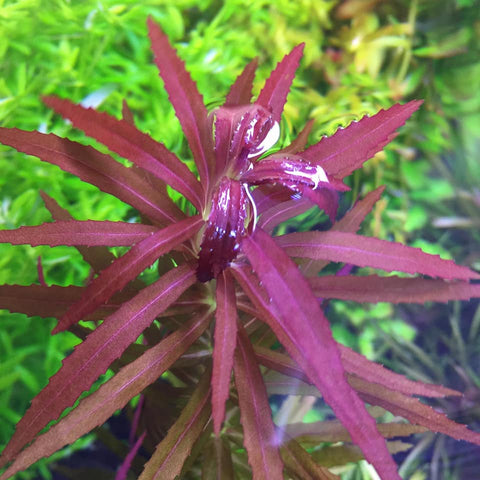Your Cart is Empty
How to grow Limnophila aromatica
February 07, 2025 2 min read

Limnophila aromatica / hippuridoides is a simple stem plant native to Asia. It is often found as a weed in Asian rice fields and is used as an aromatic herb (ngò om) in some Vietnamese soups. There is some confusion between L. aromatica and L. hippuridoides and you can read about the differences here. In general, L. hippuridoides has more leaves (6-8) per node and is more reddish, while L. aromatica is more variable (3-8 leaves) and has varieties that are greenish or reddish. Otherwise they have similar requirements.

They can be recognised by their serrated leaf edges and aromatic scent. They grow easily and will reach the water surface of most aquariums, with a diameter of between 2 and 2.5 inches. Emersed forms have fewer leaves than submerged forms.
Limnophila aromatica is tolerant of a wide range of water parameters and is an easy plant to grow. It grows tall and aggressive and is best used as a background plant. Due to its coarser leaf texture it seems to be less favoured in today's aquascapes. However, we find that it forms attractive clusters with good colouration.

Limnophila aromatica is a good background plant with attractive foliage. Here it contrasts sharply with Ludwigia sp. red and Myriophyllum 'Guyana'.
They can be pruned aggressively. This encourages the formation of side shoots and the plant can become very bushy. It is very tolerant of dense growth and can be pruned for many months without the need for replanting (the lower parts don't deteriorate as easily and will send out new shoots when the plant is pruned). It can tolerate a degree of self-shading.

Limnophila aromatica (right) beside Ludwigia arcuata (left).
Key success factors
- Sufficient light (medium onwards).
- Avoid extreme water parameters.
- Basic fertilization.
How to get it redder
- Stronger light (higher PAR values).
- Stronger red/blue light spectrum.
- Low nitrates causes the topside of the leaves to become significantly redder.
- Get the varietal that is redder.
This is one of the plants that will show redder colours under nitrate limitation. Overdo it and the plant will stunt.

Under low nitrates, the topside of the leaves can turn significantly redder.
How to trim
Cut the stem at a node some distance below the final height you want the plant to reach. Stagger the cutting height, shorter at the front and taller at the back to create a nice slope. As new shoots appear at the base of the cut stem, cut off any outlying shoots that do not match the slope of the cluster. Over time, this will produce tidy clusters of plants.
Click here to find out how to read PAR values.
Click here to find out more about water parameters for planted tank.
Click here to learn more about how to grow red aquarium plants.
unlock your true potential
Grow anything, defeat algae, create amazing aquascapes

























